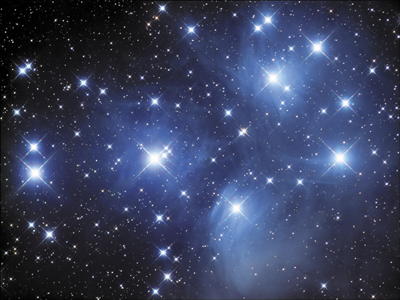For many people, the night sky seems at a glance like a chaos of random lights. But as everyone who looks up there for long realizes, a lot more is happening than meets the eye.
Even at first, a few constellations are hard to miss. One is Ursa Major, or the Big Dipper, always circling in the northern sky. Another is Orion, which comes up sideways in the southeast and clambers back down over the western horizon around 10:30 p.m. this time of year. Three stars line up in what looks like his belt, and several more hang down like a sword sheath.
The more you look, the more you see. The bright, reddish star above the belt, Betelgeuse, is in the right place for a guy’s head (and on further looking, this turns out to be his shoulder) and the one below it, Rigel, a foot. It’s hard not to think of this visual association of stars as a warrior. The starlight curve in front of him, like a bow, suggests he’s a hunter.
In our modern, scientific way of understanding things, these stars are just an accident waiting to happen to your eye. They coincidentally occupy just the right spots in the sky to form the image of an armed man. Many different cultures, for millennia at least, have not missed it.
Farther on to Betelgeuse’s right is another bright, red-hued star. This is Aldebaran in the constellation Taurus, the Bull, whose dots are not so easy to connect at first but, the more nights you spend looking, take clearer shape as two long horns angling up over Orion.
In nearly a straight line from Betelgeuse through Aldebaran is a hazy patch of light called the Pleiades. The Pleiades make the notion of accidental design harder to buy.
You can see the Pleiades in the early evening darkness before they set, these days around 10 p.m. If you look patiently at the hazy patch for a few minutes, eventually one tiny star pops out. It actually has a name, Alcyone. If you keep looking, more pinpricks appear. If you use binoculars, six stars are distinctly visible, and more fleck the area. It looks like a field of burning jewels.
This star cluster might be the most gorgeous sight in the whole sky and is so intense that for thousands of years it has loomed larger in the imagination of stargazers than it appears to the eye.
In the mid-20th century, though, the idea that the universe results randomly from physical and chemical processes began to take over our way of seeing things.
This has made it possible to shrug off the Pleiades’ beauty as a happy but meaningless accident of stars dotting our line of sight.
If you did, though, you’d in some senses be wrong.
Observations of greater detail revealed that most of the Pleiades’ stars are not near each other by chance, but are physically associated.
They’re moving together in the same south-southeasterly direction at about 25 miles per second, sort of like a flock of jewel-like birds traveling together through deep space, or like a family.
Long ago the ancient Greeks called them the Seven Sisters — one having gone astray as happens in families — with their parents, Atlas and Pleione, among them.
More is happening here than chance photons of light sparking on the back of your eye. Whole families are traveling through space. Where they are going, or whether they know it, I have no idea. I just know that the universe is constantly expanding beyond places anyone ever thought possible.
Dana Wilde lives in Troy. His writings on the stars and planets as seen from backyard Maine are collected in “Nebulae: A Backyard Cosmography,” available from Booklocker.com. Backyard Naturalist appears the second and fourth Thursdays of the month. You can contact him at naturalist@dwildepress.net.
Send questions/comments to the editors.




Success. Please wait for the page to reload. If the page does not reload within 5 seconds, please refresh the page.
Enter your email and password to access comments.
Hi, to comment on stories you must . This profile is in addition to your subscription and website login.
Already have a commenting profile? .
Invalid username/password.
Please check your email to confirm and complete your registration.
Only subscribers are eligible to post comments. Please subscribe or login first for digital access. Here’s why.
Use the form below to reset your password. When you've submitted your account email, we will send an email with a reset code.